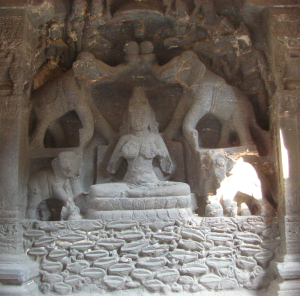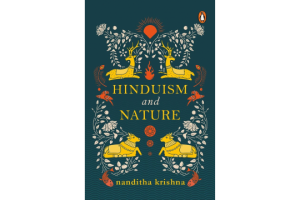Indian Culture and Nature – Part 2

On the occasion of World Environment Day
One can see a sculpture of ‘Gajalaxmi’ in the adjacent photograph. In it she is sitting on a lotus. Despite being in water the lotus remains aloof. Even the water that falls on its leaves gets washed away. While it is true that life is evanescent, it is also an indicator that every moment of it is full of beauty. The primary symbol of life is water. The symbol of everlasting life that emerges from it is lotus, the one who gives birth, the one who gives life, the one who gives regeneration can only be a mother so the goddess of nature can only be portrayed as a beautiful woman. This sculpture is like that only. The joy of creation on her face is like the satisfaction that comes from breastfeeding a baby.
On either side of Gajalaxmi, two elephants are carved filling the ‘Kalash’ with water. The sculptor did not forget to show the elephant pressing the pot under the water with its feet as it was the sculptor’s subtle observation that while filling the water, the pot had to be submerged and pressed under the water. There are two more elephants on the upper side of that elephant that are consecrating (Abhishek) her with water filled ‘Kalash’. Here the elephant is the symbol of cloud and Abhishek is the symbol of rain. The flourishing creation (Srushti) is nothing but Lakshmi. In order to indicate that this cycle is uninterrupted, continuous, the bells hanging from the swing on the back of the elephant are carved backwards, oscillating.
Lakshmi is not just an idea restricted to wealth and money. The perfect splendor nature, the wealth that arises from it. Human is the most beautiful creation of nature. Lakshmi is a beautiful replica of that human form. Here she is not only a beautiful woman but also a mother. Woman’s life is incomplete without motherhood is the fundamental concept here. Prosperity of creation (Srushti) is the real wealth; For all human beings such a ‘Jaganmata’ (mother of the universe) Lakshmi! This sculpture is called ‘Abhishek Lakshmi’. – Information Source: Late Mr. Udayan Indurkar
This sculpture is a perfect example of how nature was deeply rooted in human life.
Let us see a brief glimpse of what we can further learn about Indian culture and nature, from Nanditha Krishna’s book Hinduism and Nature.
The great medical scientist Charaka was prescient when he predicted, ‘Due to pollution of weather, several types of diseases will come up and they will ruin the country. Therefore, collect the medicinal plants before the beginning of terrible diseases and change in the nature of the earth’ (Charaka Samhita, ‘Vimanasthanam’, 3.2). With the advent of modern medicine, Charaka has been forgotten.
‘From pollution two types of diseases occur in human beings. The first is related to the body and the other to the mind, and both are interrelated . . . coolness, warmth and air––these are three virtues of the body. When they are balanced in the body it is free from disease’ (Mahabharata, XIII.16.811).
The ancient Hindu texts discourage the destruction of nature, including of wild and cultivated plants. Rishis and sanyasis were expected to live on fruits and nuts in order to avoid the destruction of plants. Throughout the Vedas, we sense a deep respect for life. The ‘Aushadhi Sukta’ of the Rig Veda addresses plants and vegetables as ‘O Mother! Hundreds are your birth places and thousands are your shoots’ (X.97.2). The Atharva Veda mentions the names of some herbs with their values. A medicinal herb is a goddess born on earth (VI.136). Later, this information became an important source of material for Ayurveda. The Rig Veda very specifically says that forests should not be destroyed (VIII.1.13). The Atharva Veda says: ‘The earth is the keeper of creation, container of forests, trees and herbs’ (XII.1.57–61). Plants are live (XII.1.57–61); ‘Plants and herbs destroy poisons (pollutants)’ (VIII.7.10); ‘Purity of atmosphere checks poisoning (pollution)’ (VIII.2.25); and ‘Plants possess the qualities of all duties and they are saviours of humanity’ (VIII.7.4).
The need to protect and conserve biological diversity is exemplified in the representation of the family and habitat of god Shiva, his consort Parvati and his two sons Karttikeya and Ganesha. His habitat is Mount Kailas, with snowy peaks representing the cosmic heavens. The crescent moon on his forehead denotes tranquillity; the constant stream of Ganga’s water from the lock of hair on his head indicates the purity and importance of water; Nandi, his bull mount, represents the world of animals; serpents signify the presence of toxicity in nature; the lion used by his consort Parvati represents wildlife; the peacock, the mount of Karttikeya, represents the avian species; and the mouse, the mount of Ganesha, represents small underground animals. Different types of animals and birds inhabit the holy abode of Lord Shiva. Another significant aspect is the harmonious relationship between natural enemies. In Lord Shiva’s household, various natural enemies live in harmony with each other. The carnivorous lion’s food is the vegetarian bull, the peacock is the enemy of the serpent and the mouse is the serpent’s food; nevertheless, all live together.
Hindu traditions acknowledge that all life forms––humans, animals and plants––are equal and sacred, and thus appropriately placed to take on contemporary concerns like deforestation, intensive farming of animals, global warming and climate change. Forests have always been central to Indian civilization, representing the feminine principle in prakriti. They are the primary source of life and fertility, a refuge for the wanderer and a home for the seeker, and have always been viewed as a model for societal and civilizational evolution. Forests were the primary source of life and inspiration, not a wilderness to be feared or conquered.
Hindu philosophy believes that the earth and all life forms––human, animal and plant––are a part of Divinity. Man evolved out of these life forms and is a part of the creative process, neither separate nor superior. We must change our lifestyle and habits to simplify our material desires, without taking more than our reasonable share of resources. Acting with an understanding of karma and the cycle of birth, death and rebirth are the central principles towards protecting the earth and the forests. ‘Everything is divine,’ says the Bhagavad Gita.
The practice of vana mahotsava (tree plantation ceremony) is an ancient tradition. Matsya Purana speaks about it. Agni Purana says that the plantation of trees and creation of gardens lead to the eradication of sin. In the Padma Purana (56.40–41) the cutting down of a green tree is an offence punishable in hell. Thus protecting the forest and expanding it was regarded as a sacred duty.
This primordial or cosmic matter of nature is made up of five elements––Prithvi (Earth), Vayu (Air), Agni (Fire or Energy), Aapa (Water) and Akasha (Space)––better known as the pancha-maha-bhuta. Their proper balance and harmony are essential for the well-being of humankind, and maintenance of this harmony is a dharma, or righteous duty.
Reference: Hinduism and Nature – Krishna, Nanditha.
Image Source: Vanarambh
A Book Must Read:
Also Read: Indian Culture And Nature – Part 1








